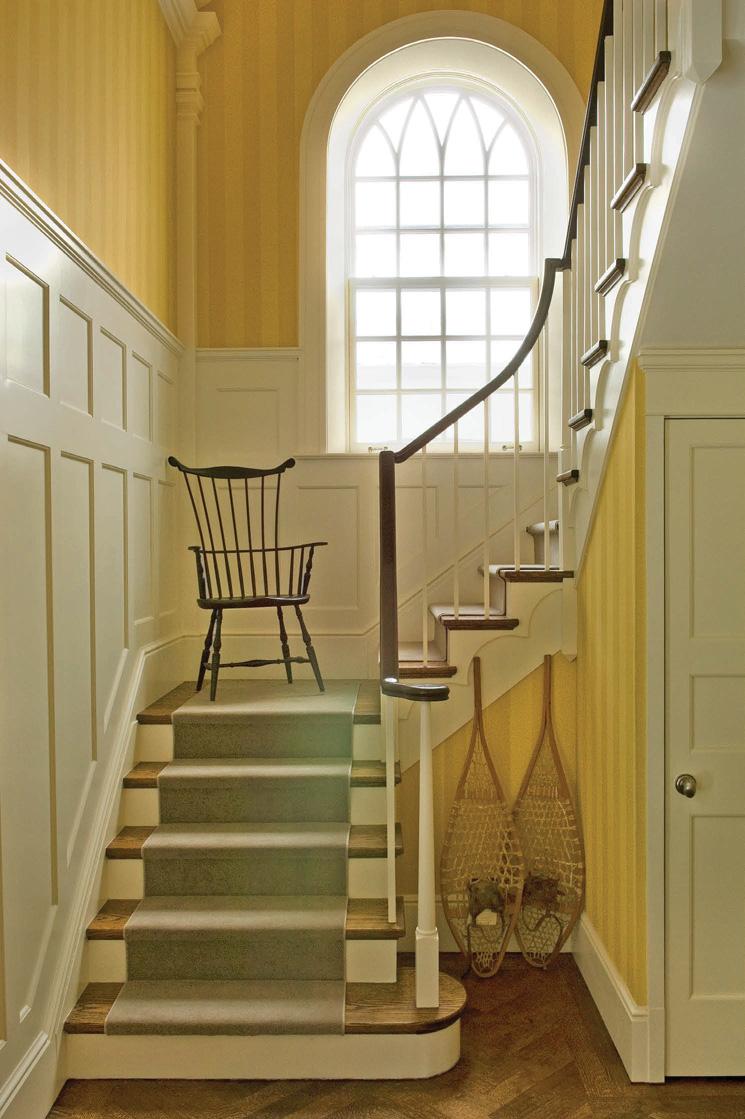試す 金 - 無料
Carpeting the Stairs
Old House Journal
|May - June 2023
A staircase runner adds comfort and safety, color, pattern, and a period touch.

I'll admit I waited a while before carpeting my stairs. We'd spent a year replacing the worn-out, chipped and painted treads with hand-finished oak and were enjoying the beautiful wood. A couple of winters with wet shoes and muddy paws showed it was time to preserve that woodwork. I decided that a carpet runner would protect the treads but still show off the oak, while making the steps less slippery and thus safer. A stair runner is also period-appropriate for my Victorian house.
The first step was deciding on the installation method: either Hollywood or waterfall. The Hollywood (or French cap or upholstered) method wraps the carpet around the edge of the tread nosing at each step, fastening it to the riser for a fitted look. This is best on stairs that get a lot of attention, as at entries and landings, in principal hallways, in main bedroom corridors. The waterfall method is more casual. Here the carpet is secured to the edge of the stair tread but then drops straight down to the back of the next tread without being tacked to the riser. This technique is usually saved for thicker, harder-to-handle carpet and for secondary passageways such as kitchen or basement stairs. My staircase was meant to be a showstopper, so I chose the more formal Hollywood method.

このストーリーは、Old House Journal の May - June 2023 版からのものです。
Magzter GOLD を購読すると、厳選された何千ものプレミアム記事や、10,000 以上の雑誌や新聞にアクセスできます。
すでに購読者ですか? サインイン
Old House Journal からのその他のストーリー

Old House Journal
designing built-in living spaces
I want an alcove just for me. Kind of like a hideout separate from the commotion in the rest of the house from which to read, write, nap, or just daydream. I want to be aware of the action in the house but be able to turn my shoulder politely and be by myself. So goes the design brief from one of our clients. She's not alone in her desire for personal scale and place-making in home design; this is a common human need.
1 mins
January - February 2026

Old House Journal
ASK OHJ
For the past year or so, the brick surround of my fireplace (below the opening, underneath a stone hearth) has been producing a white-ish dust.
4 mins
January - February 2026

Old House Journal
a bungalow Out West
A restoration prodigy restores a 1915 Arts & Crafts bungalow in Sheridan, Wyoming, and that leads to a successful career.
2 mins
January - February 2026

Old House Journal
Just the way it was
Original elements remain in this 1914 Prairie-influenced house: handsome wood and leaded windows, the brick fire-place, wainscot and trim, and even kitchen cabinets. Deftly added upgrades in period mode enhance the exemplary restoration.
2 mins
January - February 2026

Old House Journal
Matching Old Mouldings
There comes a time in the life of every old-house owner when we need to match a section of existing wood moulding.
4 mins
January - February 2026

Old House Journal
Victorian Update
A sophisticated kitchen renovation corrects anachronisms in an 1891 house undergoing restoration.
2 mins
January - February 2026

Old House Journal
NEW INSULATION FOR OLD WALLS
If after insulating the attic, weather-stripping windows, and addressing infiltration, an energy audit recommends upgrading wall insulation, the first step is to find out what's already in there, if anything.
1 mins
January - February 2026

Old House Journal
Finishing Secrets FOR FURNITURE-GRADE TRIM
Whether you're staining a door, built-in cabinetry, or any of the millwork in between, follow these steps for a flawless finish.
5 mins
January - February 2026

Old House Journal
art deco BATHS IN BLACK & WHITE
OWNERS OF A 1926 HOUSE DECIDE TO LOOK BACK TO THE ERA WHEN IT WAS BUILT, EMBRACING BOLD LUXURY.
2 mins
January - February 2026

Old House Journal
English Garden Inspiration
In what was an old Columbus schoolyard, Hoerr Schaudt Landscape Architects introduce a profusion of color and pattern.
2 mins
Winter 2026
Translate
Change font size
